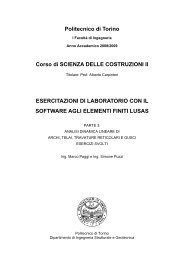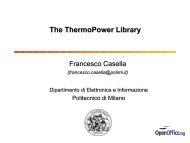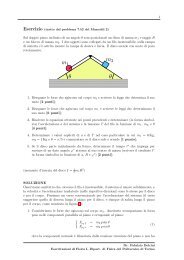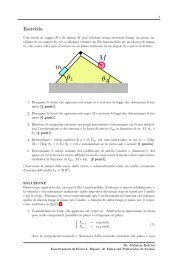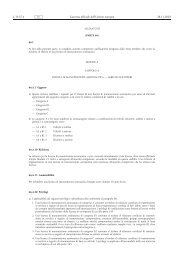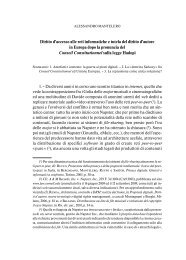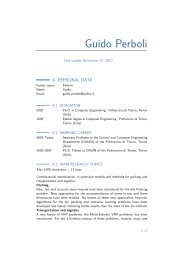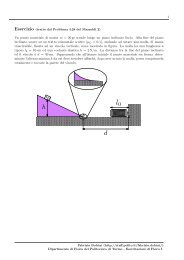The ITER toroidal field model coil project
The ITER toroidal field model coil project
The ITER toroidal field model coil project
Create successful ePaper yourself
Turn your PDF publications into a flip-book with our unique Google optimized e-Paper software.
232 A. Ulbricht et al. / Fusion Engineering and Design 73 (2005) 189–327<br />
Table 4.7<br />
Computed energy losses (grouped) for two inverter mode and a standard<br />
safety discharge<br />
Run �Ei, i =1,...,5 E1 + E2 E3 + E4 + E5<br />
[kJ] [%] [kJ] [%] [kJ] [%]<br />
IMD1 1490 3.46 1360 3.16 130.5 0.30<br />
IMD2 4337 10.08 4300 10.00 37.2 0.08<br />
SSD 42964 99.88 42310 98.36 654.3 1.52<br />
�Ei, total energy losses; E1 + E2, energy losses outside the cryostat;<br />
E3 + E4 + E5, energy losses inside the cryostat.<br />
for the safety discharge is 654.3 kJ and this is in very<br />
good agreement with the experimental values of the<br />
integrated heat load shown in Fig. 4.33. Also for the<br />
safety discharge, the biggest contribution to the energy<br />
losses inside the vacuum vessel is generated in the<br />
TFMC radial plates (i.e., 265.5 kJ) and it is transferred<br />
to the conductor by the heat diffusion process [63]<br />
described in Section 6.<br />
<strong>The</strong> first two columns of Table 4.7 show the total<br />
energy losses for the three cases—in kJ and in % of the<br />
total energy stored in the <strong>coil</strong>. At first sight, the inverter<br />
mode discharge (IMD1), where the total energy losses<br />
are at the minimum, appears as the most convenient.<br />
But, if one analyses separately the losses in the external<br />
bus bar system and the losses in the cryostat, the simultaneous<br />
ramping down strategy (IMD2) appears to be<br />
more convenient for the cryogenic plant (i.e., energy<br />
losses of 0.08% of the total stored magnetic energy in<br />
the <strong>coil</strong> against 0.30% of IMD1). <strong>The</strong> safety discharge<br />
is the more severe for the operation of the cryogenic<br />
plant (i.e., total energy losses 1.52%), but has to be<br />
retained as backup protection in case of failure of the<br />
inverter mode discharge.<br />
An additional advantage of simultaneous ramping<br />
down of the currents in magnetically coupled circuits<br />
has to do also with the behaviour of the thyristor converter<br />
during switching off of the firing pulses. Usually<br />
this action is performed by the thyristor firing pulses<br />
controller when the current in the circuit is below a<br />
minimum threshold. When the thyristor firing pulses<br />
are turned off, induced currents from magnetically<br />
coupled circuit, although of modest amplitude, might<br />
inhibit the last active pair of thyristor to switch off.<br />
In this case the AC input voltage (i.e., 50 V peak at<br />
50 Hz) is applied directly to the load present at the DC<br />
side.<br />
Fig. 4.34. TFMC AC/DC converter failure to switch off during an<br />
inverter mode discharge in combined operation of LCT <strong>coil</strong> and<br />
TFMC.<br />
<strong>The</strong> fault just described occurred a few times<br />
during the power system set up Phase 2 (see<br />
Fig. 4.34). As mentioned in Section 4.3.2.1, during<br />
an inverter mode discharge (i.e., dI1/dt = −18 A/s and<br />
dI2/dt = −1000 A/s), with initial current flows in the<br />
LCT <strong>coil</strong> at 2.3 kA and in TFMC at 10 kA, the integrated<br />
heat load for the TFMC windings, shown in<br />
Fig. 4.10, reached about 600 kJ which is of the same<br />
order of magnitude as the energy losses of the standard<br />
safety discharge. <strong>The</strong> computed current in the TFMC<br />
windings with a sinusoidal voltage source of 50 V and<br />
50 Hz, as shown in Fig. 4.35, is 123 A (rms) which produces,<br />
for 2 min, 5.13 kW (rms) of losses in the radial<br />
plates due to the eddy currents. <strong>The</strong> quench detectors,<br />
based on compensated voltages, and integration over<br />
0.5 s period, did not intervene. Unfortunately, due to<br />
the tight time schedule of the tests, it was not possible<br />
to change the control software of the 30 kA and 50 kA<br />
power supplies to allow a simultaneous ramp down during<br />
an inverter mode discharge and therefore most of<br />
the protective actions had to be implemented with the<br />
safety discharge.



